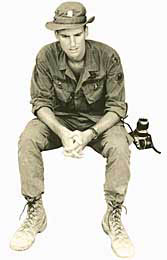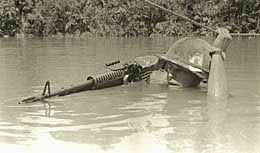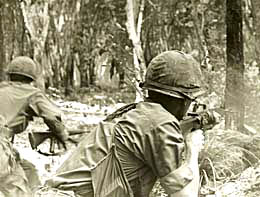Correspondents / Photographers
 Larry Weist, 2nd Battalion, 14th
Infantry Regiment, 12/67 to 03/69
Larry Weist, 2nd Battalion, 14th
Infantry Regiment, 12/67 to 03/69
Larry Weist served with the 1st platoon of Alpha Company, 2/14th, and then
became a correspondent in the field with the 2/14th. The following article
by Deseret News staff writer Joe Bauman gives some insights into the daily life
of a war correspondent.
Photo scrapbook opens flood
of memories
for Vietnam vet
By Joe Bauman
Deseret News staff writer
A package that arrived unexpectedly in the
mail opened up a flood of memories and images for a Utah Vietnam veteran.
Larry Weist, who covers Davis County for the
Deseret News, photographed dramatic scenes during his stint as an infantryman.
Serving in the Army's 25th Infantry Division from December 1967 to March 1969,
he was a rifleman, radio-telephone operator and squad leader.
 He also contributed photographs and articles to
various Army publications.
He also contributed photographs and articles to
various Army publications.
Weist was wounded twice. His medals include the
Purple Heart, Bronze Star, Army Commendation Medal and Combat Infantry Badge. In
later years, he became a board member of the Utah Vietnam Era Veterans Memorial
Committee and president of the 25th Infantry Division Association.
It was because of his role with the association
that Dennis Johansen was able to track Weist down and mail him the package.
Johansen, from San Luis Obispo, Calif., was a
friend in the service. "He and I worked in the PIO (public information
office) of the 25th Infantry Division," Weist said.
 In Cu Chi, South Vietnam, the two worked as
journalists for the 25th Division weekly paper, Tropic Lightning News; the Army
Times; Stars and Stripes; and other publications.
In Cu Chi, South Vietnam, the two worked as
journalists for the 25th Division weekly paper, Tropic Lightning News; the Army
Times; Stars and Stripes; and other publications.
"The last time I saw him was early
1970," Weist said. By then both were back in civilian life, and Weist drove
from Oakland to Santa Barbara, Calif., to visit Johansen and his wife.
They lost track of each other until recently.
Not long before Veterans Day, Johansen logged
onto an Internet site maintained by the 25th Infantry Division Association 25thida.com
and ran across a photo of a platoon marching across a rice paddy. He recognized
it as one Weist took in 1968.
Johansen contacted the association, which
forwarded Weist's address. Then Johansen, who owns a camera store and
professional photo scanning equipment, copied a batch of photos he had that
Weist had shot in Vietnam.
 He made fine prints from the scans, put them in a
loose-leaf notebook and sent them to Weist.
He made fine prints from the scans, put them in a
loose-leaf notebook and sent them to Weist.
Weist opened the mail to find a big group of
photos he took in Vietnam. He was surprised and delighted with them, and the
experience prompted him to dig through storage areas at his home in Bountiful.
He found scores of his Vietnam photographs,
packed in photo paper boxes, manila envelopes and slide containers.
"We processed that stuff ourselves under
really bad conditions," he recalled. Decades later, the unfiltered water,
poor chemicals and insufficient fixing time are combining to turn a few of the
photos brown and yellow.
While some of the images are fading, the memories
are not. And many of the images are gripping documents.
 Views like a firefight in the jungle, searching
enemy shelters or slogging through swamps are as vivid as many famous war
photographs.
Views like a firefight in the jungle, searching
enemy shelters or slogging through swamps are as vivid as many famous war
photographs.
"Oh, I remember all of the water and the
mud, because mostly those photos were taken in the rainy season for some
reason," Weist said. "All of that awful mud and leeches and mud and
mud and more mud."
In one view, a soldier is climbing up a stream
bank.
"We were walking down some some kind of
stream," Weist said. "I got up on the right bank to take his picture.
He got up on the left bank about the same time, went about 10 feet, and stepped
on a land mine."
Weist snapped his photo "just seconds before
he (the soldier) got hit."
Another view shows the evacuation by medical
helicopter of two other men who were injured by land mines.
During a sweep through a village looking for
enemy soldiers, Weist took photos from the top of a tank. "The same day, we
went out to a fire-support base or something, and they were sweeping the
road." Men on foot used metal detectors to search for land mines.
"They missed a mine. And the tank I was on,
the first tank, went over OK, but the second tank behind us set off the mine and
lost a right track." He doesn't think anyone was hurt in that incident.
Combat photography was part of an experience that
remains deeply significant for Weist.
"Life was fun, the job made sense, it was
interesting," he said. It was "nice to be young."
Thanks to
Larry Weist, 2nd Bn., 14th Inf. for the photos and information on this page
Deseret News ©2004 article by Deseret News, all rights reserved,
Kirk Ramsey, 2nd Bn., 14th Inf. for preparing this page.
This page last modified 8-12-2004
©2004 25th Infantry Division Association. All rights reserved.